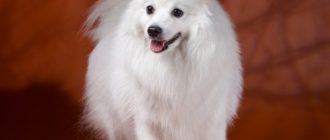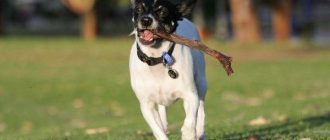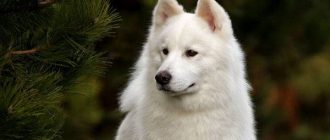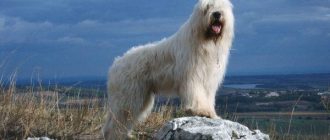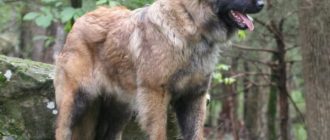Assessment of breed characteristics
Contents
| Adaptability Definition of how easy a dog is. can adapt to changes in life. |  |
| Shedding Level Level and frequency of hair loss in animal. |  |
| Level of tenderness Level and amount of tenderness and affection that the dog gives back in return for attention to itself. |  |
| Need for Exercise Daily Activity Level dogs. |  |
| Social need Required number of dog contacts with other animals as well as people. |  |
| Housing ratio Factor that determines the level of noise and other inconvenience that the dog can deliver to the owners in the ratio apartment size to dog size. |  |
| Grooming Number of bathing, combing, as well as necessary number of professional grooming sessions required the dog. |  |
| Friendliness in an unfamiliar environment society with strangers or in an unfamiliar environment. |  |
| The tendency to bark The tendency to bark and its frequency and volume. |  |
| Health Issues Potential Health Status dogs. |  |
| Territorial tendency of the dog to protect his house, yard or even a car owner. |  |
| Cat friendliness A trend towards cat tolerance and reduced manifestation of hunting instincts. |  |
| Intelligence Dog’s ability to think and solve emerging difficulties (not to be confused with learning!). |  |
| Education and training Level of difficulty in training a dog perform certain actions. |  |
| Friendliness for children Factor determining how much the dog friendly to children, whether she likes to play with them and endure some children’s pranks. |  |
| Game activity The concept is determined by its very name, and, usually found in almost all dogs. |  |
| Observing Dog’s ability to detect presence a stranger in his territory. |  |
| Friendliness for other dogs Dog’s tendency to find common language with other relatives. |  |
Brief description of the breed
Boston Terriers are companion dogs that work great in as true friends for modern residents of big cities. These small dogs are good-natured to people and animals, take up little places, unpretentious in leaving. Bred in the mid-19th century in United States, Boston Terriers have long been popular for outside this country, today they are loved and often acquired in as four-legged pets in Russia. Although in European countries the breed is more popular than in our country. So, Boston Terriers (or Boston Terriers) are small dogs strong enough and proportional addition. Height at the withers dogs of this breed is equal to the length of the body. Boston Terriers divided by the International Cynological Federation into 3 “weight” class: dogs weighing less than 6.8 kg, dogs weighing from 6.8 kg to 9 kg, dogs weighing from 9 to 11 kg. Externally, Boston Terriers are similar to their the closest ancestors – English terriers and Old English bulldogs. By the body’s warehouse they resemble terriers, and in the face, accordingly, bulldogs. The heroes of this article have a skull box has a square shape, the forehead and cheekbones of the dogs are flat, eyebrows expressed. Transition from forehead to wide and short square muzzle the forms are quite pronounced. The eyes are round, large, dark in color. The nose is wide and large, black. Medium sized ears high set, standing (can be stopped). Jaws Bostonians are wide, form a bite or a direct bite. Neck pretty high set, proportional in length and width to everything torso. The chest is wide and deep. The back of the dog is less than average lengths (case looks rather short), ribs are convex. Tail tapering to the tip, short, low set. Hips Muscular The limbs are short and strong (especially the back). Paws small in size with small claws. Wool Boston Terriers short and thin, without pronounced undercoat. Color may be black with white marks (white coat color around the muzzle, white hole between the dog’s eyes, on the chest, on the limbs), brindle or black-brown (shade of a fur seal).
Photo Boston Terrier:
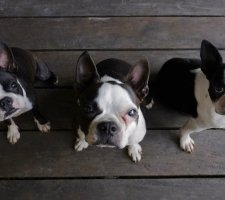
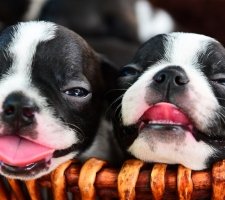

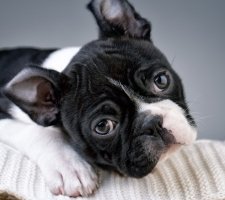
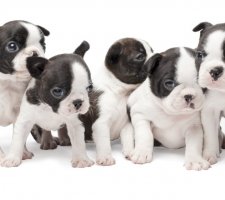
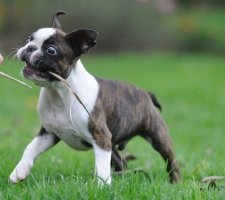
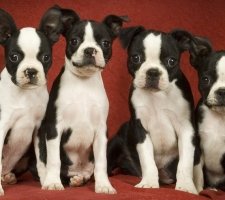
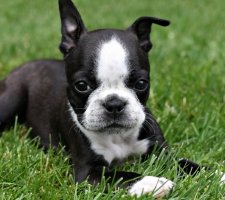
 Photo of Boston Terrier dogs |
Photo of Boston Terrier dogs |
Origin history
The early birth of dogs that were the ancestors of today Boston Terriers, refers to the 60s of the 19th century in the USA in the city Boston, which gave the name to the breed. The basis of the breeders were blood of dogs of such breeds was taken: Old English Bulldog, Bull Terrier, french terrier, english terrier, pit bull, boxer (often highlight the English Terrier and the Old English Bulldog). In 1891 The first Boston Terrier Club in the United States was established in the year. 2 years later, in 1983, Boston Terriers recognized by the American Cynological club as an independent breed. Until that time Boston Terriers are often represented at the shows as American bull terriers, which was fundamentally wrong, because neither externally nor internally, these breeds are not similar. Although in creating the Boston breed terriers and fighting dogs participated, on their character it is not reflected. Today, this breed is among the 20 most popular in The United States.
Character Boston Terrier
Boston Terriers – dogs with a balanced psyche, morally calm, lovingly loving not only the owner, but all members families, including young children. We can say that Bostonians are full participants in all events in the house of his master. They are curious, energetic, love traveling, active walks, behave during which they are excellent, without inconvenience to anyone. Sociable Boston Terriers are not intrusive, although they love games and affection, shown to them by people. Dogs of this breed neat, with proper training, do not bring the owner to the head pain in the form of spoiled furniture, torn curtains, puddles on the carpet. Also, these small pets are not “barking,” but they can cast a voice if they feel any danger. They are not the most the best watchmen, if only because of their good natured character, but at Necessity can scare away the ill-wisher from mastery. Other pets in the house are treated well, often with pleasure. are friends with cats and dogs. In some cases Boston males can compete with their dogs gender, but rarely comes to the present conflict.
Maintenance and care
The small size of the Boston Terriers allows you to keep them even in small apartment. But not only because of the size of these dogs lodged indoors – they are very sensitive to cold and heat, temperature differences (which is often the case in Russia). Dog’s place in the house can be arranged where there are no drafts, heat, in moderation light, it is desirable that the animal could see from its bed the owner and family members. Can place a Boston Terrier toys, always constantly next to the bed should be bowl of clean water. In the first months of life, a puppy can be equipped and a toilet (a tray with a filler for a dog’s toilet, and sometimes use disposable diapers, sawdust, paper instead of filler – at the request of the owner). Walking with the Boston Terrier is a must as an animal sitting in four walls (especially in loneliness), over time it will become depressive and lethargic, which will affect not only the character, but also his health. Unhurried walking around the perimeter of a yard or a walking area is boring and uninteresting occupation for the Boston. These animals are happy perform learned commands of the owner, run, pass lanes obstacles, communicate with other tailed brothers, actively spend time in nature. They need at least two walks daily for 1-1.5 hours. In frost and heat time walks can be shortened a bit. By the way, at minus temperature Boston Terriers wear overalls and shoes that you can to purchase both in pet stores, and to sew independently. IN there are no special features of the Boston Terriers – natural food or ready-made quality food (for dogs appropriate size and age). Feeding an adult is done twice a day – morning and evening. Do not treat the animal with treats with tables, especially sweet, greasy, spicy foods, are also not needed give boston terrier bones. Natural food dogs need at least 2 times a year to take vitamins, which should recommend a doctor according to weight, age, condition Boston Health and Diet. Shorthair Care Boston terriers are simple – combing 1 or 2 times a week, shampooing for dogs 2-3 times a year (or as it gets dirty). Shedding in Boston Terriers is not pronounced, which beneficial for owners whose furniture, flooring and clothing will not be in dog hair. Short muzzle after eating should be wiped with a napkin. Eyes (often “soul mirrors” are a weak point in dogs of this breed) should also be wiped daily with a cotton pad, dipped in warm water (sometimes tea is used instead of water tea leaves). Be sure to wipe the ears of the Boston Terrier weekly (if water or a special tool for cleaning ears from sulfur). The claws of a family pet are trimmed twice a month.
Training and education
The small size of the Boston Terriers allows you to keep them even in small apartment. But not only because of the size of these dogs lodged indoors – they are very sensitive to cold and heat, temperature differences (which is often the case in Russia). Dog’s place in the house can be arranged where there are no drafts, heat, in moderation light, it is desirable that the animal could see from its bed the owner and family members. Can place a Boston Terrier toys, always constantly next to the bed should be bowl of clean water. In the first months of life, a puppy can be equipped and a toilet (a tray with a filler for a dog’s toilet, and sometimes use disposable diapers, sawdust, paper instead of filler – at the request of the owner). Walking with the Boston Terrier is a must as an animal sitting in four walls (especially in loneliness), over time it will become depressive and lethargic, which will affect not only the character, but also his health. Unhurried walking around the perimeter of a yard or a walking area is boring and uninteresting occupation for the Boston. These animals are happy perform learned commands of the owner, run, pass lanes obstacles, communicate with other tailed brothers, actively spend time in nature. They need at least two walks daily for 1-1.5 hours. In frost and heat time walks can be shortened a bit. By the way, at minus temperature Boston Terriers wear overalls and shoes that you can to purchase both in pet stores, and to sew independently. IN there are no special features of the Boston Terriers – natural food or ready-made quality food (for dogs appropriate size and age). Feeding an adult is done twice a day – morning and evening. Do not treat the animal with treats with tables, especially sweet, greasy, spicy foods, are also not needed give boston terrier bones. Natural food dogs need at least 2 times a year to take vitamins, which should recommend a doctor according to weight, age, condition Boston Health and Diet. Shorthair Care Boston terriers are simple – combing 1 or 2 times a week, shampooing for dogs 2-3 times a year (or as it gets dirty). Shedding in Boston Terriers is not pronounced, which beneficial for owners whose furniture, flooring and clothing will not be in dog hair. Short muzzle after eating should be wiped with a napkin. Eyes (often “soul mirrors” are a weak point in dogs of this breed) should also be wiped daily with a cotton pad, dipped in warm water (sometimes tea is used instead of water tea leaves). Be sure to wipe the ears of the Boston Terrier weekly (if water or a special tool for cleaning ears from sulfur). The claws of a family pet are trimmed twice a month.
Health and Disease
Boston Terriers live for about 12-15 years (sometimes exceeding this boundary), they are quite active and inquisitive to the most respectable age. The main problems with these dogs are:
- From the gastrointestinal tract (flatulence, pylorospasm);
- From the side of vision (cataract, eye injury);
- From the musculoskeletal system (dislocations joints);
- Skin diseases (demodicosis, atopy, allergic reactions);
- Oncology (melanoma, mastocytoma);
- Deafness (congenital).
Boston Terrier females most often require obstetric care in the form of Caesarean section, as the puppies head is quite large for them miniature mother. Little puppies are born in the litter – most often from 2 to 4.

